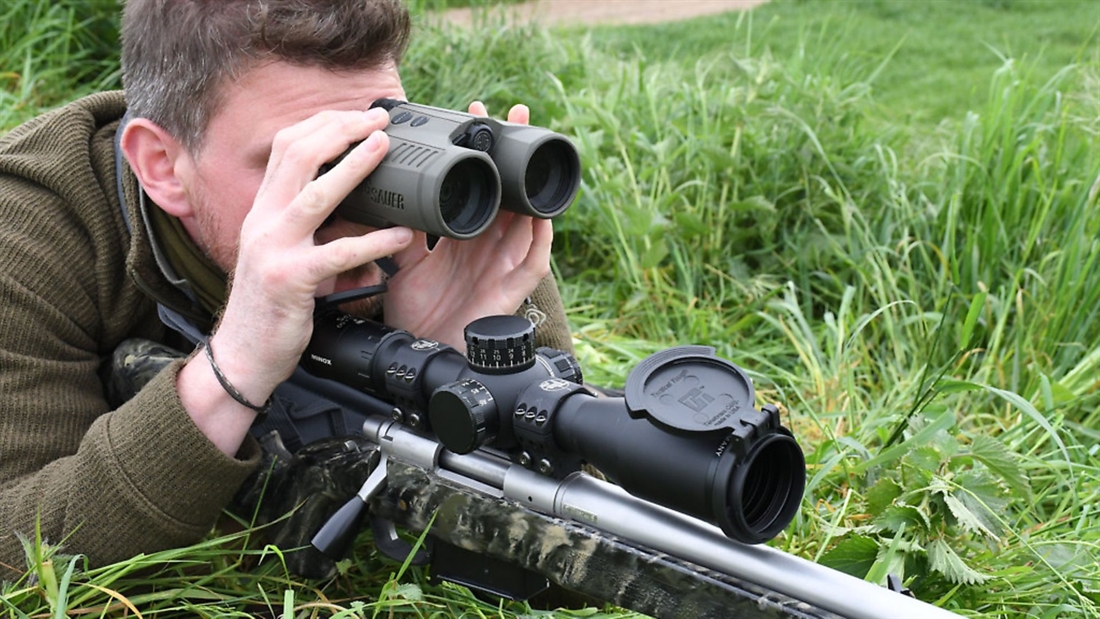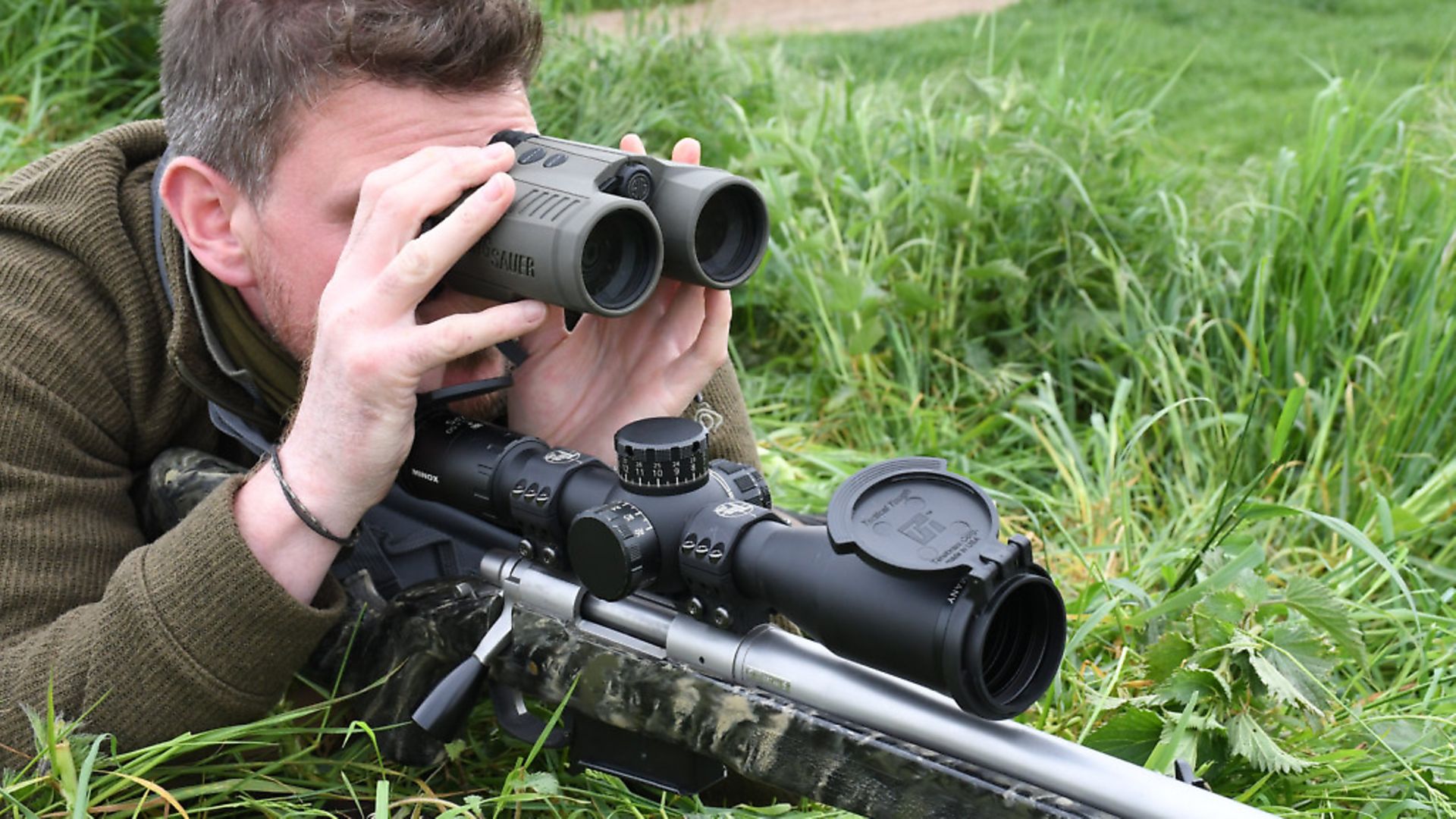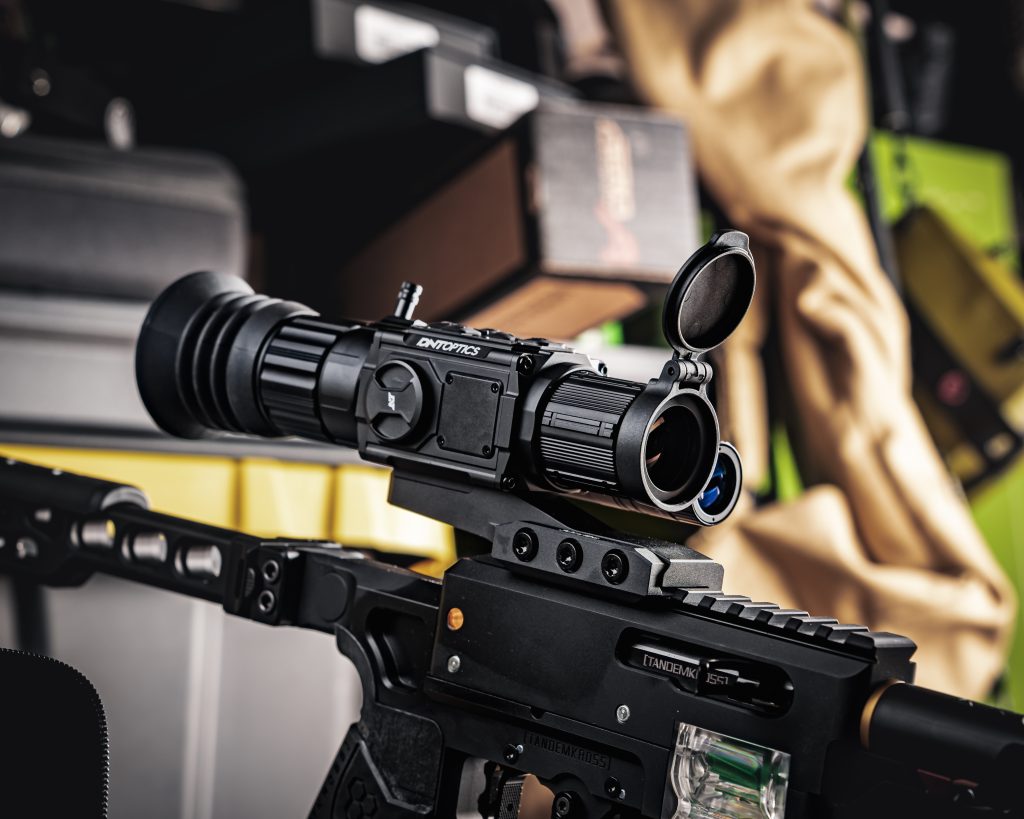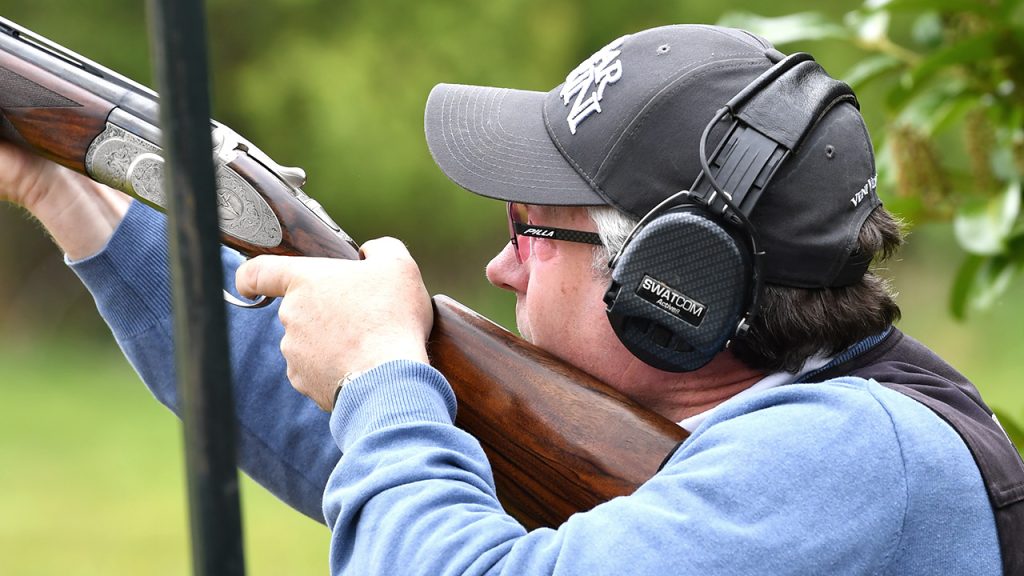Sig Sauer Kilo 3000 BDX 10×42 Laser Rangefinding Binoculars – test & review

Chris Parkin was a fan of these awesome range finding binoculars – the Sig Sauer KILO 3000 BDX 10×42 Rangefinding Binos – which feature hassle-free electronics and a reasonable price tag!
I first experienced Sig Sauer’s BDX (Ballistic Data Exchange) system on a sika deer hunt in Ireland last September. I found the combination of a handheld rangefinder with a Sierra 3 BDX riflescope to be well presented, with no functional flaws and easy to set up.
The reliable Bluetooth 4.0 connection to my phone during initial set-up was key to my enjoyment. The guys at Sig told me that the aerial design used on these binos ensure that, when it comes to making the shot, nothing will stop the rangefinder telling the scope the distance, allowing it to project its ballistically calculated aim point within the scope’s reticle.
Carrying a rangefinder alongside binoculars and rifle is something many of us are used to, but some are fortunate enough to combine their hardware; so it was only to be expected that Sig would combine their 3000 binocular rangefinder with their BDX capability.
Although the riflescope was not of the highest optical capability in low light when compared to European elite non-electronic units, the balance between specification, functionality, compact size, weight and general ease of use greatly impressed me. Often, my contact with new electronic tech in the rifle shooting world is regularly beset by patchy comms, but, to their absolute credit, Sig have made things reliable and easy to use here.
The 3000s have similar programming steps to the smaller Kilo monoculars that were extensively covered a few months ago (the 2400 BDX being the one I’m most familiar with). These Kilo 3000s have a 10×42 compact roof prism layout with rubber-armoured magnesium housing for lightweight and tactile grip. Each tube has a grip-filling lump on its underbelly, filling your palm, and a single CR2 battery compartment snuggled between, under a screw cap.
With the rubberised eye cups screwed right down, the binos are only 145mm front to back, which is remarkably compact, with an overall weight of 900g.
A neck strap/chest harness rig is supplied and pre-assembled. It fits over both shoulders, holding the binos tight to your chest with a folding top shield that flips away from you, allowing the binos, still restrained with a secondary harness, to lift to your eyes. In heavy cover or when crawling, this gives total protection to the optics and negates the need for irritating ocular and objective lens caps that, generally speaking, are always flapping about somewhere you don’t want them. The clips to separate the binoculars from the chest rig are small and a bit tricky with gloves on if you need to remove or refit them in a hurry, but such is life!
Each eyecup has three extending positions to fit your preferred eye position (glasses or not) relative to the 18mm inbuilt eye relief. This is more than satisfactory when sitting or standing, but given the ballistic capability and the likelihood of being used regularly from prone, a few extra millimetres might have helped when the eyebrows are holding the cups away from your eyeballs.
Being a rangefinder with internal OLED display, both sides have dioptre adjusters to make sure that, firstly, the screen is in focus for the right eye, then that both eyes are balanced together (using the left), and finally the focus knob can sharpen the picture in regular conditions as range-to-target changes, just like a regular binocular.
I occasionally found this balance needed readjusting, and wasn’t able to notice if something had been physically nudged (the collars don’t have obvious visible markings) or if it was just a factor of vastly differing target ranges.
This dial is 24mm long and 32mm in diameter, mounted at the rear of the single 70mm hinge connecting both tubes and enabling adjustment of the inter-pupillary distance. The focus dial enjoys a smooth rotation with a tactile grip and offers a 280° rotation spanning focus from 5m to infinity, although the depth of field was more limited than that of some competitors. My hands generally fit into size large gloves and while my fingertip sat on the focus wheel with a comfortable hold, it was about as far as I would be comfortable with. The stout build of the unit might be too bulky for smaller hands. The anchors for the harness sat right beneath the first knuckle of my index finger and palm, laying flush within the armour so a comfortable hold is maintained – just be sure they are right for your hands.
The objective lenses sit about 4mm within the armoured body, meaning their convex surface is close to being damaged on even the slightest uneven surface it’s placed upon – so, make sure to use the harness and case! They become very comfortable and, with multiple quick-detach buckles, are easy to put on and quite modular in the way they fit.
In use, I found the image bright and crisp with good clarity and colour rendition, only losing out to top-end rangefinding units such as my Leicas by around 10 minutes at dusk in terms of detail recognition capability. In full daylight, the picture was a little grainier but perfectly functional with no visual strain from tube misalignment after long periods of observation.
Eyecups are soft rubber with radiused edges, locking into my eye sockets with enough space for the nose to remain clear of the focus dial.
Pop the battery in and all will spring to life. There are two control buttons on top: the front one for menu functions, the rear for rangefinding. After pressing the rear button to illuminate the circular aiming reticle, holding the menu button down for a few seconds initiates the logical menu structure. Don’t get me wrong, the bigger the internal OLED display screen, the more detrimental the effect due to extra elements within the lens and prism packages adversely affecting light transmission figures. On the other hand, some displays are so small and complex that you can’t read the icons or words. Here, they have used acronyms, rather than combinations of seven segment LCD/LED figure-eight combinations flashing like the Predators wristband.
Rangefinding modes are: line of sight (displays direct distance to target); or AMR mode (angle modified range, taking account of inclination or declination of your shot, with the angle displayed for your further ballistic calculations).
Alternatively, you can use ABU mode, which is set up using your phone/tablet and allows the on-board computer to work alone, using Applied Ballistics Ultralite software to supply firing solutions for your pre-programmed ammunition recipe. This will display results out to 800m/yards (your choice) which, for actual hunting, should be sufficient. Selecting ABX will apply Applied Ballistics External, and here is where things get really fun. With BDX function to transmit to the riflescope, ABU is great for presenting the required aim over point within your reticle on a Sig BDX scope, but for serious long ranges on targets, ABX is the ultimate capability on the Kilo 3000. Again, following the set-up procedure, you can pair the Kilo to a Kestrel 5700 Elite Anemometer or Garmin Foretrex 701 ballistic computer to process range to target, inclination angle and atmospheric variables into what is currently the best ballistic solver in the business, with little further introduction needed.
If you have a Kestrel or Garmin, you will need to be familiar with the controls of the products in their own right to see where the assistance fits together. Basically, when the two are connected, the Kestrel, for example, can be left on a separate tripod mount with its wind vane constantly updating wind speed and direction relative to the target’s compass bearing. Each time you press the range button on the Kilo, the distance to target is updated and the Kestrel returns the elevation and windage values required, straight into the eyes of the binocular viewer for the suggested shot solution.
From that very first press of reticle illumination, the range readout is virtually instantaneous, with ballistic readout in three seconds and windage a further second after that. This value readout is maintained for 20 seconds, or until a further operation is started, and that gives you plenty of time.
All the usual wind reading instrument caveats apply, but when paired to a spotter alongside the shooter, cross-reference of information and data is crucial at long-range and extended long-range with the spotters’ eyes never having to leave the magnified optical tool to work the Kestrel. The only hole in proceedings is that the initial bearing from shooter to target needs to be entered into the Kestrel manually, and although it can thereafter be left to freely rotate into the wind direction, further presses on the Kilo do not update the compass bearing to target (although they do update the range). Realistically, unless your targets are all in line, you will have to physically return to the Kestrel and set the new bearing to target by aligning it and pressing ‘capture’.
When used wirelessly on a phone/tablet, this value can be entered remotely from the firing point using a compass, without the need to touch the Kestrel. That involves taking two tools into the shower, however – and losing eye contact through the binoculars or spotting scope with the target. There is no real winner in that one. I suspect the deeper issue is that having two electronic compasses in close proximity and equal priority might lead to electronic disagreements, because they are always a little fickle and susceptible to interference. If the compass on the Kestrel alone is in charge, this can’t occur, but that’s my personal feeling and not an official response from either company, both of whom I respect for their empirically technical approach (rather than resorting to marketing hype).
So, given that slight chink in fictional Shangri-La, how can the Kilo 3000 regain its worth? Well, it is a damn good rangefinder. The laser is STRONG! Most RF monocular and binoculars have a rectangular bean shape projected into the distance, with a beaten zone wider than it is tall. This sometimes makes it easier to get returns from target with the unit on its side to avoid intervening obstacles with a laterally narrower beam, but the Kilo uses a circular bean akin to the reticle shape subtended within.
Single presses or continuous hold on the range button fire out the laser at up to four pulses per second (HyperScan and LightWave DSP Technologies) with the reading, in scan mode, updating range to target in metres or yards equally quickly.
In scan mode, when a unit flashes up, RangeLock hangs onto that last strong reading. It is best to release the button when your desired point of aim pops out from its background, but to help matters, there is the option to set up the best or last result from this laser strike. For a hunting rather than range-based situation, it takes less than a minute to swap the Kilo into ABU mode for ballistic readout on screen from your chosen ammunition; up to 25 ammunitions can be saved in the app, which I found simple to use with clear black/white technical layout on screen, rather than disruptive artistic control screen art.
Sig specify approximate distance capabilities depending on target reflectivity of both the laser and ambient light; most rangefinders will work more efficiently and at greater ranges as bright sunshine diminishes due to the lessening confusion and scatter effects. Ratings in yards of up to 1,500 (deer), 2,000 (trees) and a crazy sounding 5,000 yards on reflective targets, I found all to be very honest, and made me seek out new test locations to push the limits on my usual maximum 1,700m. Scanning trees and houses rather than targets, I got readings just over 4000m just prior to dusk, and that is impressive.
The round reticle at 10x magnification was consistent to use with repeat readings correct, relative to target size and aiming steadiness, although I will say that repeating that 4,000m reading the following morning failed in the brighter light.
Lumatic Display automatically calibrates display brightness to changing ambient light conditions. Other than in really low-light hunting situations, where any rangefinding binocular will struggle relative to non RF peers, this is an impressive unit that has crushed the slight optical lag from European brands with a hard-hitting, reliable and easily controlled rangefinder that almost eclipses the fact they are great binoculars in their own right (all covered by Sig Sauer’s ‘Infinate Guarantee’ and ‘Electronics Limited Warranty’).
The Sig BDX app for smartphone in iOS or Android supports G1 and G7 ballistic coefficients for ease of set-up, rather than consulting endless tables of obscure factory bullets.
Long-range shooting, as it is referred to, is unlikely to occur without accurate chronograph velocity data, so not tailoring ballistics accurately is wasted time before getting into the field where the real world creates far more hassle between your muzzle and the target. Displayed elevation and windage units in MOA or mRad are supported, the latter with a directional arrow for left or right on the OLED screen just to keep everything clear.
To sum up, as a rangefinding tool with all the functional capability advertised, the Kilo 3000 outranks the competition. At this price, it’s acceptable that they sacrifice a little of the optical performance of less ballistically capable rivals that are perhaps more for hunting, rather than shooting competitors. These were £500 cheaper than I was expecting, and do what they say on paper, with functional ease and reliability in the real world.
Suggested retail price: £1,567.95
Contact: Highland Outdoors Limited 0845 099 0252 www.highlandoutdoors.co.uk
Related Articles
Get the latest news delivered direct to your door
Subscribe to Rifle Shooter
Elevate your shooting experience with a subscription to Rifle Shooter magazine, the UK’s premier publication for dedicated rifle enthusiasts.
Whether you’re a seasoned shot or new to the sport, Rifle Shooter delivers expert insights, in-depth gear reviews and invaluable techniques to enhance your skills. Each bi-monthly issue brings you the latest in deer stalking, foxing, long-range shooting, and international hunting adventures, all crafted by leading experts from Britain and around the world.
By subscribing, you’ll not only save on the retail price but also gain exclusive access to £2 million Public Liability Insurance, covering recreational and professional use of shotguns, rifles, and airguns.
Don’t miss out on the opportunity to join a community of passionate shooters and stay at the forefront of rifle technology and technique.





